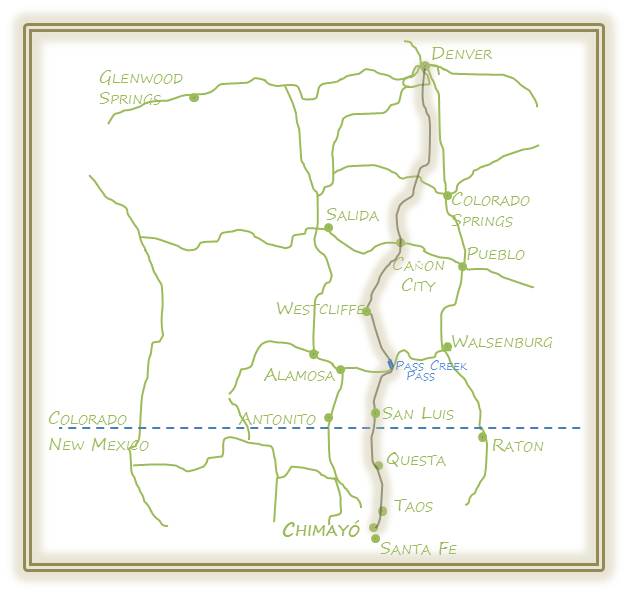Camino del Norte to Chimayó
A series of three existing routes were used to lead pilgrims between Denver and Chimayó: first, a miner’s route connecting Denver with the silver mining area of Cripple Creek; second, the Ute Indian migration path between the Front Range and the San Luis Valley that was also used by Zebulon Pike during his early exploration of the region following the Louisiana Purchase; finally, the upper reaches of the Rio Grande river used by the Franciscan Missionaries during the time of the Spanish Colonials. Most of the route is made up of graded forest roads, with the remainder on paved country roads. The route would be suitable for foot, off-road wheelchair and mountain bike.
Unlike the caminos in Spain, no network of pilgrim houses exists appropriately spaced to facilitate the pilgrimage. The feasibility of a pilgrim house system in Colorado and northern New Mexico was tested in the pioneer effort. The route originates in Denver, crosses the mountains between Monument and Woodland Park, again at Cripple Creek to Canon City, and into the San Luis Valley at Pass Creek Pass. Although the route passes through some villages and towns, shade and water stations were set up to support pilgrims with refreshments.
The pioneer pilgrims who made the pilgrimage along this Camino del Norte a Chimayo varied widely in background and level of experience. The success of the journey was overwhelming. It was a challenge for most, far beyond any effort they had previously attempted. There was general consensus that the most difficult part was that the distances were beyond the comfort level of most. The spacing of towns cannot be changed, so it is what it is. Perhaps in the future, interim stations would be established to make the stages a bit shorter though it would extend the number of days of the pilgrimage.
Advice to others interested in making the pilgrimage reasonably includes being well prepared both physically - to be able to walk 20 miles without getting blisters - and mentally - to be able to spend hours on end alone and unattached to electronic devices. The scenery, history and culture that the camino passes through is remarkable. The camino is real.
Anyone interested in making this pilgrimage is encouraged to contact the Our Lady of Guadalupe Parish at 303 477 1402 or the Santuario de Chimayo at 505 351 9961. Alternatively, an email inquiry can be sent through the link above.
Tuesday, June 19, 2012
Updates
Saturday, June 9, 2012
Collecting Pilgrims
We're collecting quite a diverse group of pilgrims interested in participating with the Our Lady of Guadalupe parish as well as some individuals interested in walking only parts of the Camino to Chimayó. This is just what the art of pilgrimage is all about... diversity.
At the moment (early June) a big focus of the organizing effort is in establishing the hospitality part of the pilgrimage - where pilgrims will be accommodated each night. Simultaneously, pilgrims can step forward soon to announce their intention of participation. By early July the effort will evolve into being sure pilgrims have all the details they want and are prepared to begin the great walk by the end of July.
